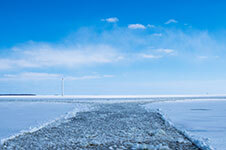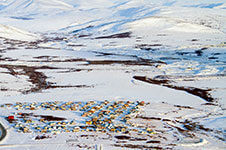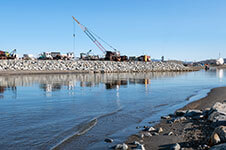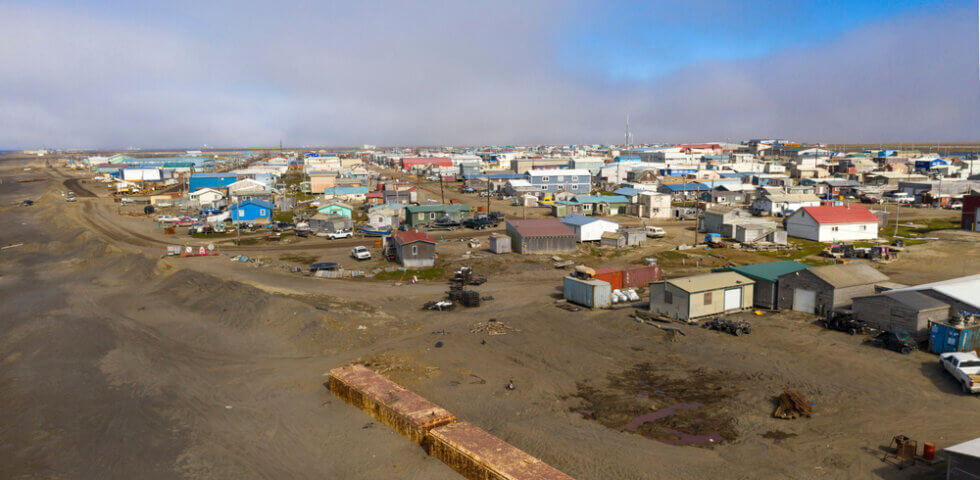Poor broadband access has always been a challenge for rural Alaska communities. As more businesses and organizations are offering services online, communities without reliable and affordable internet services are at a steep disadvantage. This topic has received a lot of coverage as of late, but these communities need active support — and they need it quickly.
One of the biggest barriers facing rural Alaska communities, especially those in remote Arctic regions, is building out infrastructure to support widespread access for Alaskans across the state.
At Quintillion, we are very well-versed in regards to the issues our Alaska community faces when it comes to poor broadband access. Not only that, but we’re also extremely passionate when it comes to enabling rural Alaska communities to better access the digital world, and therefore take advantage of all of the services and economical benefits that come with it.
Building a fiber backbone along the Northwest coast and North Slope came with challenges. However, witnessing how this fiber optic cable system has spurred the digital movement in these communities has been extremely rewarding. We couldn’t be more excited to partner with the Alaska community in efforts to continue to help tribes become more connected.
To make this goal a reality, there are still many barriers to broadband access for rural Alaska communities that need to be addressed. And we believe that understanding these obstacles is the first step to discovering solutions that can create lasting, transformative change.
1. Education and Access to Government Funding
Recently, The Infrastructure Investment and Jobs Act has afforded the federal government the ability to put out several funding opportunities for underserved communities in the country. Part of this act included the Tribal Broadband Connectivity Program. This first round of funding allocated $980 million in grants, which enabled communities to build out the necessary telecommunication infrastructure, and therefore facilitate broadband deployment for a wide range of uses, including:
- Workforce development
- Telemedicine
- Teletherapy
- Distance learning
- Ecommerce
- Emergency services
- Government programs
- Streaming
- Online gaming
These grants offered a great opportunity for native tribal governments to help develop their communities and enhance their people’s quality of life. However, even in this situation, poor broadband access created a barrier for community leaders to take advantage of this funding.
With this first round of grants, about half of the tribes who were eligible for this funding applied. There was a short 90-day application window, and the information and submission process were primarily completed online. And while there were several webinars and other resource available to help these communities better understand the application requirements, most of these could only be accessed online as well.
For communities who have to rely on public facilities to access broadband, it can be challenging to learn about and apply for these resources. Tribes require more time, more information, and better access to get these applications, and they require timely information about approval and future grant opportunities.
2. Affordability of Internet Services
In a recent roundtable discussion by the Committee of Indian Affairs, Senator Lisa Murkowski spoke on the importance of affordability for internet services in Alaska Native communities.
“When we haven’t addressed the issue of affordability, we haven’t done anything to improve the access. In some of the villages, you might have access to internet, but if it costs $300 a month for 10 Mbps, you’re not going to sign up. You might as well not have anything at all.”
Alaska is known as “America’s Last Frontier” because it is massive and relatively untamed when compared to the rest of the nation. And while there are sections of the state, such as Anchorage, Juneau, and Fairbanks, where large populations of people live and work, much of Alaska is less developed and sparsely populated. Many communities have no roads and are only accessible by boat or two plane rides.
Being able to build out infrastructure that covers this large of an area when people are so spread out from each other creates a significant logistical issue in providing outlying communities with reliable internet service. And the difficulties and expenses associated with developing this infrastructure can have a direct impact on the end user, bringing up the cost internet providers charge for these services.
3.Coordination With Federal and State Governments
With funding coming into both tribal governments and state governments, tribal communities that do receive grant funding may struggle to coordinate with federal and state governments as the land ownership situation in Alaska is complicated.
- 2/3 is owned by the U.S. Government, which is split between the Bureau of Land Management, the U.S. Fish & Wildlife Service, the National Park Service, U.S. Forest Service, and the Department of Defense
- 1/4 is owned by the state of Alaska
- 1/10 is owned privately, which includes about 40 million acres of ANCSA Native Corporation land and 5.9 million acres of local government and non-ANCSA land
From gaining permits to building out robust networks, deploying broadband services requires a great deal of handling and coordination from multiple entities. While Alaska has a newly appointed broadband taskforce to help act as a liaison and coordinate between tribes and state and federal governments, Alaska still lacks a broadband office, which many other states have.
This broadband office would have the potential to help navigate many of the barriers to broadband access for Alaska Natives and the state as a whole. For instance, one issue mentioned during the roundtable commission is the need for more accurate, substantial data on the scope of Alaska’s broadband issue.
A dedicated broadband office could create a full digital equity plan, including a speed test analysis, physical gap information, and a list of unserved or underserved locations. And an essential part of this process would be keeping tribes involved in this process, thus providing them with a voice and role in developing their communities.
4. Support for Digital Literacy
The digital landscape has changed drastically in only a few years. While younger generations may be more acquainted with the internet and other modern digital tools, this technology is relatively new to communities who only recently acquired middle-mile infrastructure.
As more communities gain access to broadband, digital literacy is an essential component for making tools such as telemedicine and remote work practical for residents. Digital literacy is also important in understanding the potential risks (such as cybercrimes) that come with internet use, and being aware of such risks in both their personal and professional uses/applications.
There is support that can be offered to help communities adjust to new technology. Resources, such as tool kits, can be dispersed. In addition, universities and other educational institutions can also offer help and play a vital role. However, it takes significant time, money, and planning to implement this type of training, especially for adults.
5. Construction and Maintenance of Infrastructure
The scale of broadband issues is great in Alaska, even when compared to tribal communities in other parts of the U.S. In some locations, a middle-mile backbone already exists, and the primary issue lies in extending internet services to consumers through last-mile networks supplied through internet service providers.
However, in parts of Alaska where fiber does not currently reach, the first issue is building out fiber optic cable networks in this area. And the terrain and dispersion of populations in the state makes building these middle-mile systems a unique challenge.
Quintillion played a significant role in doing what no one else had done before when building an extensive subsea and terrestrial fiber optic cable system in the Alaska Arctic. However, there are still many areas of the state that have not been reached, as getting fiber to these locations is both logistically difficult and incredibly costly.
Additionally, while government funding can potentially cover the costs of building out infrastructure, the expenses don’t end once these systems are in place. This infrastructure needs to be maintained (and sometimes repaired), both of which can be financially unfeasible for some tribal communities.
Breaking Down Barriers and Bridging the Digital Divide
The barriers to broadband access in rural Alaska communities are significant, and there aren’t easy, readily applicable solutions to each of these issues. However, bringing these issues to light is essential if we want to break down these obstacles and find true solutions. At Quintillion, we choose to be active in this matter as we all work toward a more connected Alaska community.
We can bridge the digital divide together. Contact the Quintillion team to learn more.















